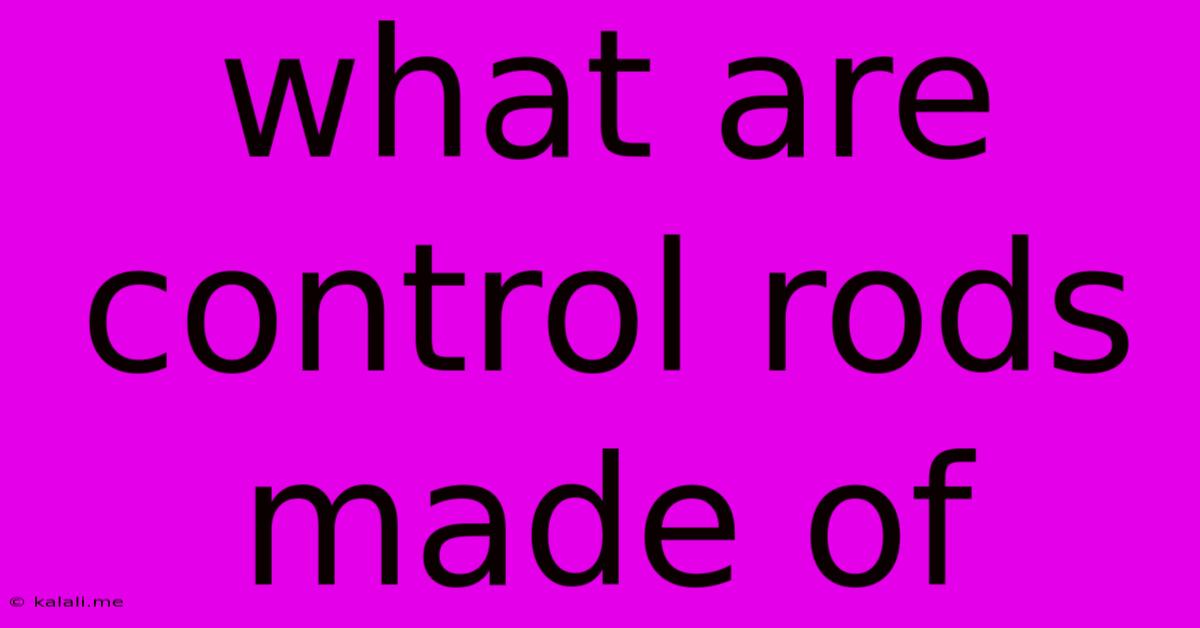What Are Control Rods Made Of
Kalali
May 21, 2025 · 3 min read

Table of Contents
What Are Control Rods Made Of? Understanding Nuclear Reactor Safety
Nuclear reactors are incredibly powerful, generating vast amounts of energy. But this power needs precise control to prevent accidents. That's where control rods come in. These crucial components are responsible for regulating the rate of nuclear fission, ensuring the reactor operates safely and efficiently. But what exactly are these vital pieces of reactor technology made of? The answer is more complex than you might think, and understanding the materials involved reveals the intricate engineering behind nuclear safety.
This article will delve into the composition of control rods, exploring the properties that make specific materials suitable for this critical application. We'll look at the reasons behind material selection and how these components contribute to the safe and reliable operation of nuclear power plants.
The Importance of Neutron Absorption
Control rods function by absorbing neutrons, the particles responsible for sustaining the chain reaction in a nuclear reactor. By inserting or withdrawing these rods, operators can precisely control the number of free neutrons available to initiate further fission events. This directly impacts the reactor's power output. The materials used in control rods are carefully selected for their exceptional ability to absorb neutrons effectively.
Common Control Rod Materials: A Deep Dive
Several materials exhibit the necessary neutron-absorbing properties for control rod construction. The most frequently used include:
-
Boron Carbide (B<sub>4</sub>C): This ceramic material is a popular choice due to its high neutron absorption cross-section, meaning it's exceptionally good at capturing neutrons. Boron carbide is also relatively inexpensive, durable, and chemically stable, making it a practical and reliable option. It’s often used in the form of pellets or powder, encased within a protective cladding.
-
Silver, Indium, and Cadmium (Ag-In-Cd): This alloy, often referred to as "silver-indium-cadmium" or simply Ag-In-Cd, offers a high neutron absorption capability. The specific ratios of each element are carefully adjusted to optimize performance. While offering excellent neutron absorption, this alloy is more expensive than boron carbide.
-
Hafnium (Hf): Hafnium is a relatively rare metal with a very high neutron absorption cross-section. Its superior neutron-absorbing properties make it an attractive option, but its high cost and limited availability restrict its widespread use. It’s often considered a premium alternative to other materials.
-
Other Materials: Depending on the specific reactor design and operational requirements, other materials like gadolinium or other neutron-absorbing elements might be incorporated into control rods, either alone or in combination with the primary materials listed above.
The Role of Cladding
It's crucial to remember that the neutron-absorbing material isn't directly exposed to the reactor core. It's encased within a protective cladding, usually made of stainless steel or other corrosion-resistant materials. This cladding safeguards the control rod material from the harsh, high-temperature, and highly radioactive environment within the reactor core, preventing degradation and ensuring its long-term effectiveness. The cladding must also be resistant to neutron bombardment and retain its structural integrity under extreme conditions.
Control Rod Design and Functionality
The design and physical configuration of control rods vary considerably depending on the reactor type. They can be solid rods, clusters of smaller rods, or even employ other intricate designs to optimize their effectiveness and controllability. The overall goal remains the same: to provide a precise and reliable mechanism for regulating the nuclear chain reaction, ensuring both safety and efficient power generation. Understanding these variations requires detailed knowledge of specific reactor designs.
In conclusion, the choice of materials for control rods in nuclear reactors is a critical aspect of nuclear safety. The properties of high neutron absorption, durability, and chemical stability are paramount. Materials like boron carbide, silver-indium-cadmium, and hafnium, alongside protective cladding, ensure the safe and efficient operation of these powerful energy sources.
Latest Posts
Latest Posts
-
Can I Travel On The Day My Schengen Visa Expires
May 21, 2025
-
How Do You Stop The Rain In Minecraft
May 21, 2025
-
Relationship Between Electric Field And Electric Potential
May 21, 2025
-
Bathroom Fan Light Switch Wiring Diagram
May 21, 2025
-
How To Get Rid Of Cement
May 21, 2025
Related Post
Thank you for visiting our website which covers about What Are Control Rods Made Of . We hope the information provided has been useful to you. Feel free to contact us if you have any questions or need further assistance. See you next time and don't miss to bookmark.